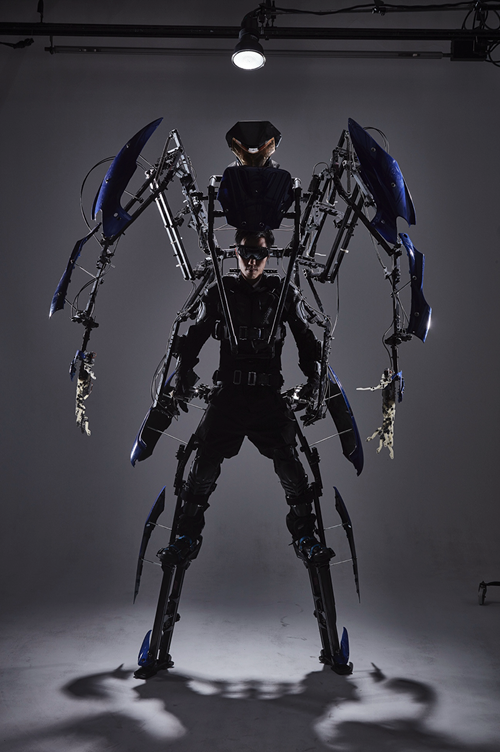Max Summer School in Geidai 2025Concert (work in progress)
This event is open to the public.
Anyone is welcome to attend. Admission is free, so please feel free to come.
Venue : Tokyo University of the Arts, Senju Campus, Hall7
Date : August 6, 2025Doors Open: 18:30 | Start
Time : 19:00
Da Viunchi’s Robot — A Will Dwelling in Shadow
Concept, Direction, Composition: Suguru Goto
Technical Advisor: Makoto Tanaka
Technical Assistants and Performer: You Seikitsu
Technical Assistants: Tei Rinsan, Li Qiongyu
This work integrates performing arts, media art, and digital music through the use of the exoskeleton robot suit “Skeletonics,” developed by Robot Ride Inc., to create a new form of stage expression. Skeletonics is a unique human-powered robot that extends the wearer’s movements using a mechanical linkage, enabling the operation of a giant 2.5 to 3-meter-tall body. Its overwhelming presence makes it a powerful artistic medium.
At the Goto Laboratory of Tokyo University of the Arts, we have conducted experiments attaching motion tracking sensors to the robot, converting the wearer’s movements in real-time into sound and visual output. Combined with DMX lighting and laser production, the project pursues an integrated expression of sound, imagery, and body — an exploration of “bodily expression through human-machine fusion.”
This work is an artistic experiment viewing technology as an extension of the body, aiming to construct a futuristic performance that resonates with the audience’s senses and perception.

“Da Viunchi’s Robot — A Will Dwelling in Shadow”
This piece begins with Leonardo da Vinci’s historical concept and design of a humanoid robot knight. Around 1495, da Vinci constructed a human-like machine with pulleys and cables, capable of moving its arms, neck, and legs — a true “mechanical human.”
Remarkably, this concept closely resembles the modern Japanese innovation, Skeletonics — a non-motorized exoskeleton suit developed by Robot Ride Inc., which amplifies the wearer’s physical motion through mechanical linkage, transmitting movement directly to a giant body. Both da Vinci’s robot and Skeletonics operate purely on human power, without motors or electronic control, symbolizing how “the memory of the body” has been connected to machines across centuries.
In this performance, the performer wearing Skeletonics generates real-time sound and light through motion tracking. Their movements sculpt a soundscape, while lighting (moving lights/dimmers), lasers, and projections transform the space into a “theater of shadows.”
Shadows move ahead of substance, speak of memory, and sometimes intersect and resonate with the audience’s own shadows. This small-scale musical drama is a poetic and physical media art experience, where light and shadow, memory and body, machine and art converge.
Weird H. and A.
Composer/Performer: Seiichiro Matsumura
Weird H. and A. is a live performance work exploring bodily extension. It uses a system where harmonies and arpeggios generated algorithmically in response to the performer’s monophonic lines are influenced by sensor data derived from body movements.
While traditional home keyboards and synthesizers feature accompaniment and arpeggiator functions to support human performance, this work expands and reimagines these functionalities in Max. When body movements act as biased parameters within the system, the result is unexpected harmonies and strange rhythms beyond human capability.
Rather than the human controlling the system, the piece presents an improvised struggle within imposed constraints, raising questions about co-creation between human and machine.
"Empathic Machines" for One Pianist's Mind and Disklavier
Composer: Masatsune Yoshio
What lies beyond the pianist’s technical skill — music in which body and mind are fully integrated?
In this work, a pianist’s brainwaves are sensed using the EMOTIV Insight device, and the data is processed in Max 9 to generate performance information that is transmitted and played by a Disklavier™ piano.
Through this body-extended expression, the resulting piano music — beyond human hand alone — becomes a speculative answer to the question posed above.
Performer: Atsushi MORI
Performer Biography:Atsushi Mori is an Associate Professor at the Junior College Division of Showa University of Music.He completed his studies in the Department of Composition and the Graduate School at Showa University of Music, studying under Kazuhisa Akita.
In 1987, he received the Silver Prize in the A1 Category of the PTNA Piano Competition, and in 1993, he performed with the Warsaw Philharmonic as part of the Yamaha JOC overseas concert tour. He composed Fanfare for the "Festival of Student Orchestras" in 2002.
In addition to his work as a composer, Mori is active as a keyboardist, providing live support, arrangements, and recordings. He also specializes in music production using DAWs such as Ableton Live and Logic, and is dedicated to the analysis of popular music and the development of solfège teaching materials. His research focuses on the integration of digital technology and music education.
Morphing Interfaces
Composer/Performer: Hiromichi Kitazume
An improvised performance involving body movement and the playing of self-made instruments to control sound synthesis and spatial audio.
Sensor and microphone signals attached to custom instruments are analyzed and processed in Max, used to control sound transformation, spatial positioning, and various effects.
This work aims to present an “augmented performance experience,” where sounds change in real time based on physical gestures and musical actions, and explores the multi-layered relationship between sound and movement.
Note: The content is based on current planning and may be subject to adjustments or changes.
Referee
Composer: Hideaki Isobe
Para-out Guitar / Outputter: Gaku Yamada
The Referee (Outputter) silently delivers judgment. This work explores how sonic “judgments” are formed, transmitted, and ultimately output, questioning the concept of social judgment through the relationship between music and processing systems. A small robot mimics the Referee’s movements as a symbolic gesture.
Structured in multiple sections, the piece contrasts density, spatial directionality, and stability of sound. It is performed with a para-out guitar, six fixed speakers, a robotic arm speaker, and a small robot.
The para-out guitar, co-developed with performer Gaku Yamada, allows each string to output independently to dedicated speakers. The robotic arm speaker is worn on the performer’s back and emits sound in multiple directions according to the performance sequence.

